4WD TOYOTA TUNDRA 2010 2.G Owners Manual
[x] Cancel search | Manufacturer: TOYOTA, Model Year: 2010, Model line: TUNDRA, Model: TOYOTA TUNDRA 2010 2.GPages: 724, PDF Size: 13.74 MB
Page 33 of 724
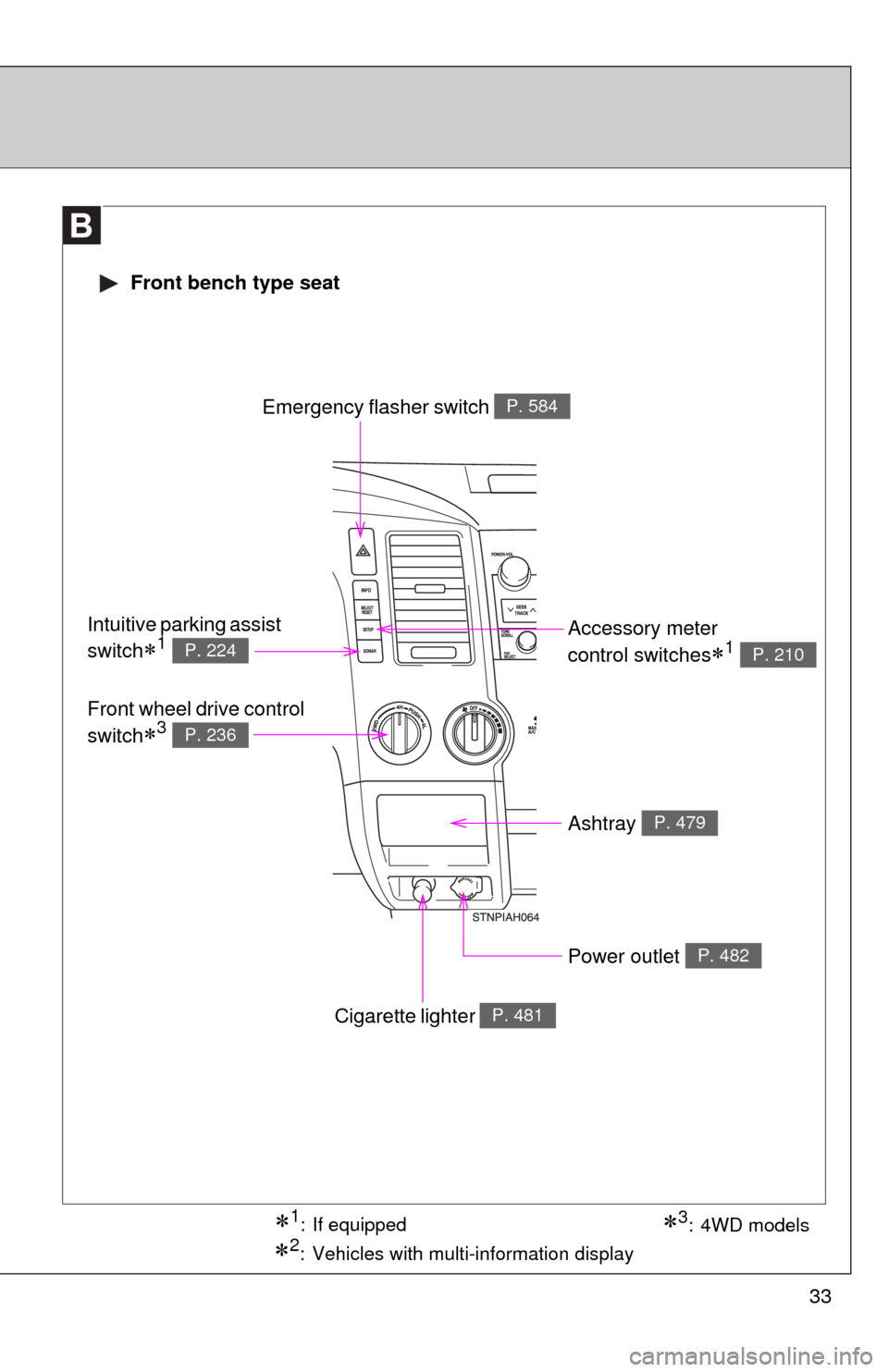
33
1: If equipped
2: Vehicles with multi-information display
3: 4WD models
Front bench type seat
Emergency flasher switch P. 584
Ashtray P. 479
Accessory meter
control switches
1 P. 210
Intuitive parking assist
switch
1 P. 224
Front wheel drive control
switch
3 P. 236
Power outlet P. 482
Cigarette lighter P. 481
Page 35 of 724
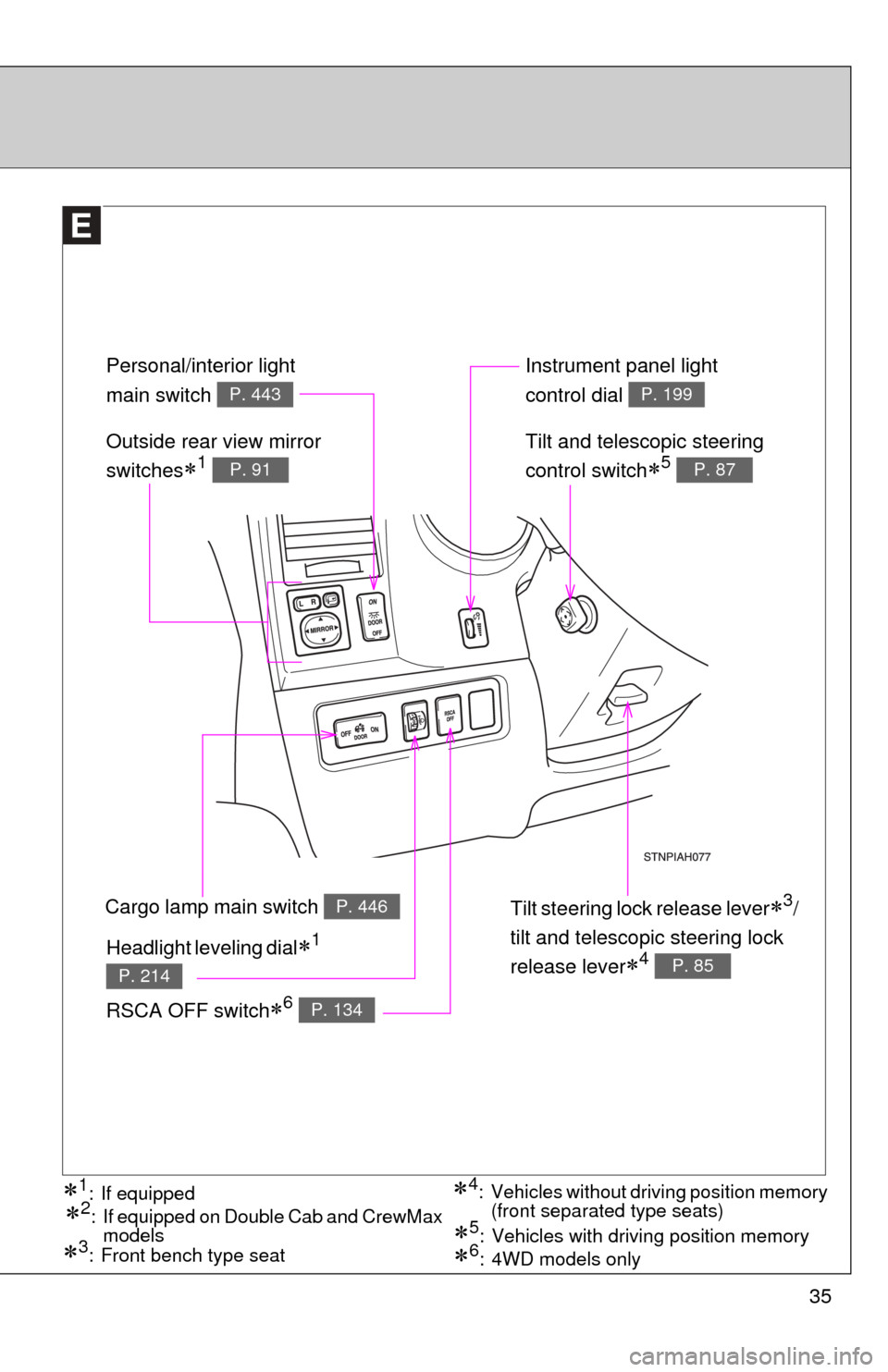
35
Instrument panel light
control dial
P. 199
Outside rear view mirror
switches
1 P. 91
Tilt steering lock release lever3/
tilt and telescopic steering lock
release lever
4 P. 85
Personal/interior light
main switch
P. 443
Cargo lamp main switch P. 446
RSCA OFF switch6 P. 134
Tilt and telescopic steering
control switch
5 P. 87
1: If equipped
2: If equipped on Double Cab and CrewMax models
3: Front bench type seat
4: Vehicles without driving position memory
(front separated type seats)
5: Vehicles with driving position memory
Headlight leveling dial1
P. 214
6: 4WD models only
Page 122 of 724

122 1-7. Safety information
Your vehicle is equipped with ADVANCED AIRBAGS designed based
on US motor vehicle safety standards (FMVSS208). The airbag sys-
tem controls airbag deployment power for the driver and right front
passenger. The driver airbag system consists of the driver seat’s
position sensor etc. The front pass enger’s airbag system consists of
the front passenger occupant classification sensor etc.
The main SRS airbag system components are shown above. The
SRS airbag system is controlled by the airbag sensor assembly. The
airbag sensor assembly consists of a safing sensor and an airbag
sensor.
Front bench type seat: The SRS airbags are designed to protect the
driver and right front passenger, and they are not designed to protect
an occupant in the front center seating position.
In certain types of severe frontal or side impacts, the SRS airbag sys-
tem triggers the airbag inflators. A chemical reaction in the inflators
quickly fills the airbags with non-toxic gas to help restrain the motion
of the occupants. Side airbags
AIR BAG ON and AIR BAG
OFF indicator lights
Curtain shield airbags
Front passenger airbag
Knee airbags
Side and curtain shield air-
bag sensors
Front airbag sensors
Airbag sensor assembly
Curtain shield airbag sen-
sors (Double Cab and
CrewMax models)
Front passenger’s seat belt
buckle switch
Occupant detection system
(ECU and sensors)
SRS warning light and
RSCA OFF indicator light
RSCA OFF switch
(4WD models only)
Driver’s seat position sen-
sor
Driver airbag
Driver’s seat belt buckle
switch
Passenger airbag off switch
(Regular Cab models)
Page 134 of 724

134 1-7. Safety information
Deactivating the curtain shield airbags in a vehicle rollover (4WD models only)
ON/OFF (hold for a few sec-
onds)
The RSCA OFF indicator turns
on. (only when the engine switch
is in the ON position.)
The roll sensing function for the
curtain shield airbags and seat
belt pretensioners will turn back
on automatically each time the
engine switch is turned on.
CAUTION
■When the passenger airbag of f switch is turned off
● Do not turn the passenger airbag off switch to the OFF position except
when a member of a passenger risk group identified in TABLE 1 is occupy-
ing the right passenger seating position.
● The front passenger airbag will not inflate in a collision and turning off the
front passenger airbag can reduce the occupant protection which your
vehicle safety systems can provide to you in certain accidents and
increase the likelihood of death or serious injuries.
■The switch only should be used
In a situation where inflation is not desired (such as during extreme off-road
driving).
■ Operating conditions when th e RSCA OFF indicator is on
● The curtain shield airbag and seat belt pretensioner will not activate in a
vehicle rollover.
● The curtain shield airbag will activate in a severe side impact.
Page 182 of 724

182 2-1. Driving procedures
NOTICE
■If you hear a squealing or scrapin g noise while driving (brake pad wear
limit indicators)
Have the brake pads checked and replaced by your Toyota dealer as soon
as possible.
The rotor damage can result if the pads are not replaced when needed.
It is dangerous to drive the vehicle when the wear limits of the brake pads
and/or that of the brake discs are exceeded.
■ If you get a flat tire while driving
A flat or damaged tire may cause the following situations. Hold the steering
wheel firmly and gradually press the brake pedal to slow down the vehicle.
●It may be difficult to control your vehicle.
● The vehicle will make abnormal sounds.
● The vehicle will behave abnormally.
Replace a flat tire with a new one. ( P. 608)
■ When encountering flooded roads
Do not drive on a road that has flooded after heavy rain etc. Doing so may
cause the following serious damage to the vehicle.
●Engine stalling
● Short in electrical components
● Engine damage caused by water immersion
In the event that you drive on a flooded road and the vehicle is flooded, be
sure to have your Toyota dealer check the following.
● Brake function
● Changes in quantity and quality of oil and fluid used for the engine, trans-
mission, transfer (4WD models), differentials, etc.
● Lubricant condition for the propeller shaft, bearings and suspension joints
(where possible) and the function of all joints, bearings, etc.
Page 202 of 724

202 2-2. Instrument cluster
■Indicators
The indicators inform the driver of the operating state of the
vehicle’s various systems.
Turn signal indicator
(P. 191)
(Canada)
Tail light indicator
( P. 213)
Headlight high beam
indicator ( P. 213)*1AUTO LSD indicator
(P. 240, 245)
(If equipped)
Security indicator
(P. 114)*1,7
RSCA OFF indicator
( P. 134)
Shift position and shift
range indicators
(P. 186)
TRAC OFF indicator
( P. 245, 246, 247)
*1AIR BAG ON indicator
(P. 136)
*1AIR BAG OFF indicator
(P. 136)
(If equipped)
Cruise control indicator
(P. 221)
(4WD models)
4HI indicator ( P. 236)
*1,5
Slip indicator
( P. 241, 244)
(4WD models)
4LO indicator ( P. 236)
*1
VSC OFF indicator
(
P. 240, 245, 246, 247)(If equipped)
TOW HAUL indicator
(P. 189)
(U.S.A.)
Headlight indicator
(P. 213)
Page 240 of 724
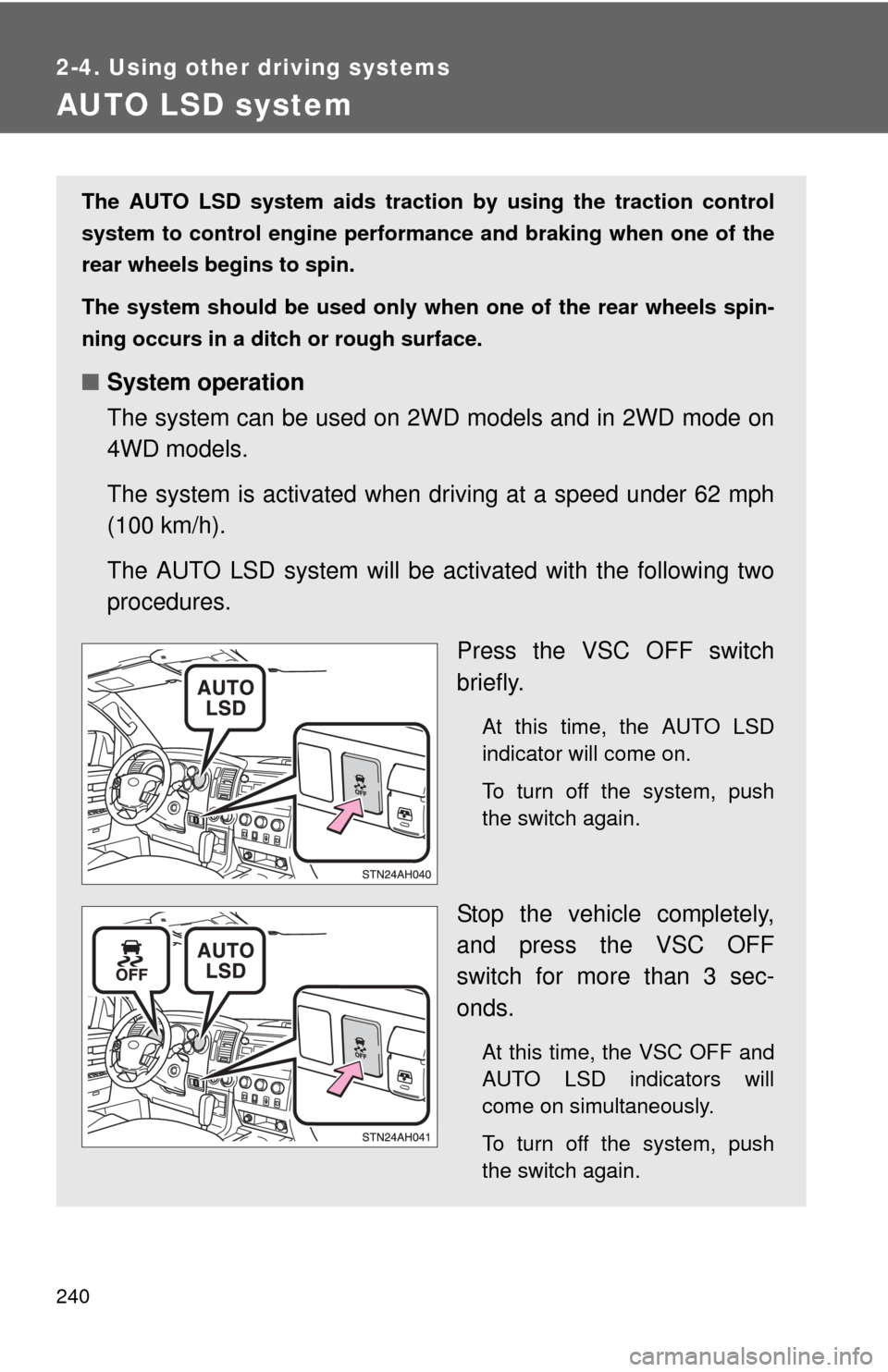
240
2-4. Using other driving systems
AUTO LSD system
The AUTO LSD system aids traction by using the traction control
system to control engine performance and braking when one of the
rear wheels begins to spin.
The system should be used only wh en one of the rear wheels spin-
ning occurs in a ditch or rough surface.
■ System operation
The system can be used on 2W D models and in 2WD mode on
4WD models.
The system is activated when dr iving at a speed under 62 mph
(100 km/h).
The AUTO LSD system will be ac tivated with the following two
procedures.
Press the VSC OFF switch
briefly.
At this time, the AUTO LSD
indicator will come on.
To turn off the system, push
the switch again.
Stop the vehicle completely,
and press the VSC OFF
switch for more than 3 sec-
onds.
At this time, the VSC OFF and
AUTO LSD indicators will
come on simultaneously.
To turn off the system, push
the switch again.
Page 243 of 724
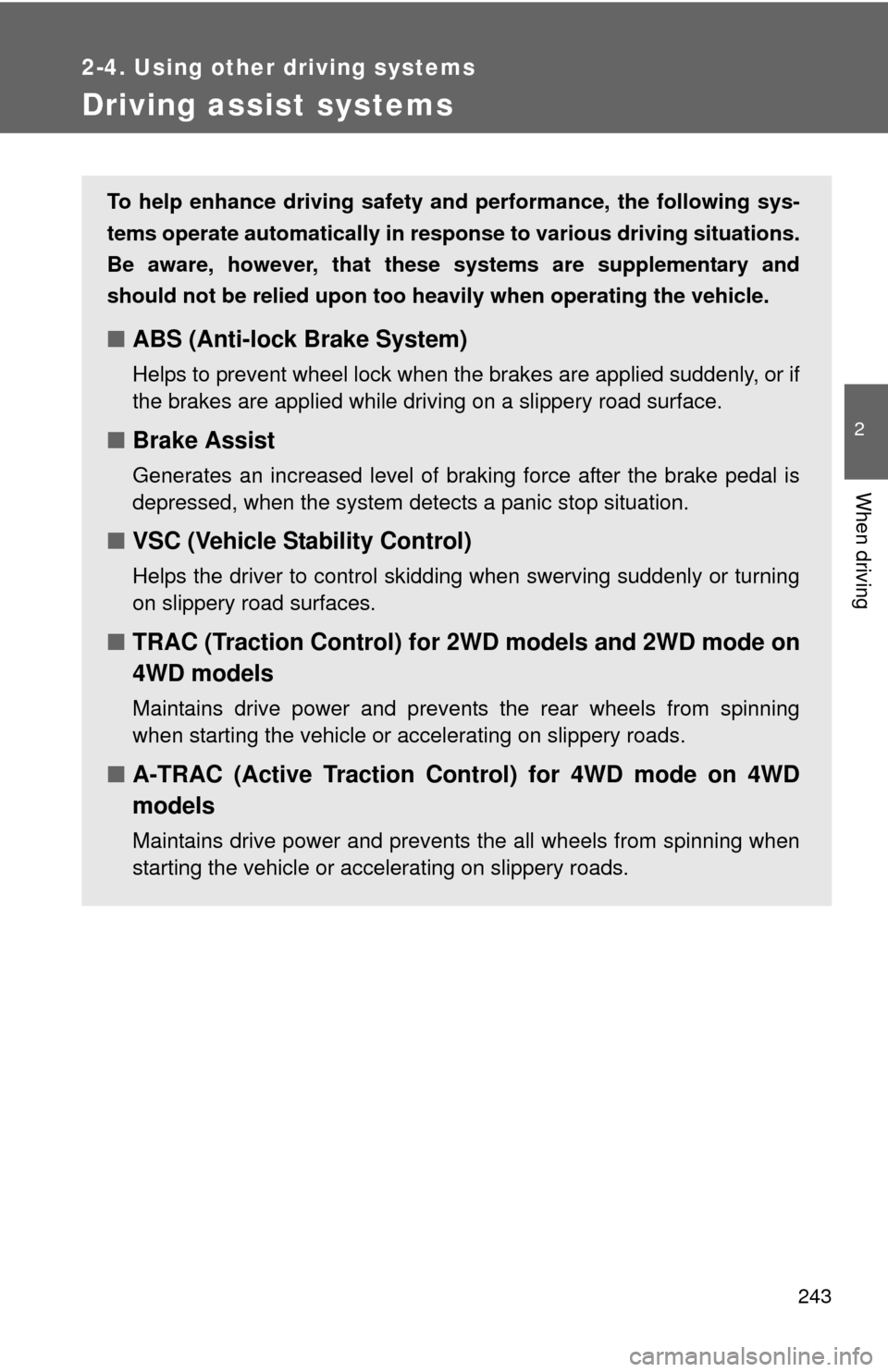
243
2-4. Using other driving systems
2
When driving
Driving assist systems
To help enhance driving safety and performance, the following sys-
tems operate automatically in res ponse to various driving situations.
Be aware, however, that these systems are supplementary and
should not be relied upon too heavi ly when operating the vehicle.
■ABS (Anti-lock Brake System)
Helps to prevent wheel lock when the brakes are applied suddenly, or if
the brakes are applied while driving on a slippery road surface.
■Brake Assist
Generates an increased level of braking force after the brake pedal is
depressed, when the system detects a panic stop situation.
■VSC (Vehicle Stability Control)
Helps the driver to control skidding when swerving suddenly or turning
on slippery road surfaces.
■TRAC (Traction Control) for 2WD models and 2WD mode on
4WD models
Maintains drive power and prevents the rear wheels from spinning
when starting the vehicle or accelerating on slippery roads.
■A-TRAC (Active Traction Control) for 4WD mode on 4WD
models
Maintains drive power and prevents the all wheels from spinning when
starting the vehicle or accelerating on slippery roads.
Page 244 of 724

244 2-4. Using other driving systems
When VSC/TRAC/A-TRAC are operatingVehicles with multi-information display If the vehicle is in danger of slip-
ping, or if the rear wheels (2WD
models and 2WD mode on 4WD
models) or all wheels (4WD
mode on 4WD models) spin, the
slip indicator flashes to indicate
that VSC/TRAC/A-TRAC have
been engaged.
A buzzer (intermittent) sounds to
indicate that VSC is operating.
Vehicles without multi-information displayIf the vehicle is in danger of slip-
ping, or if the rear wheels (2WD
models and 2WD mode on 4WD
models) or all wheels (4WD
mode on 4WD models) spin, the
slip indicator flashes to indicate
that VSC/TRAC/A-TRAC have
been engaged.
A buzzer (intermittent) sounds to
indicate that VSC is operating.
Page 245 of 724
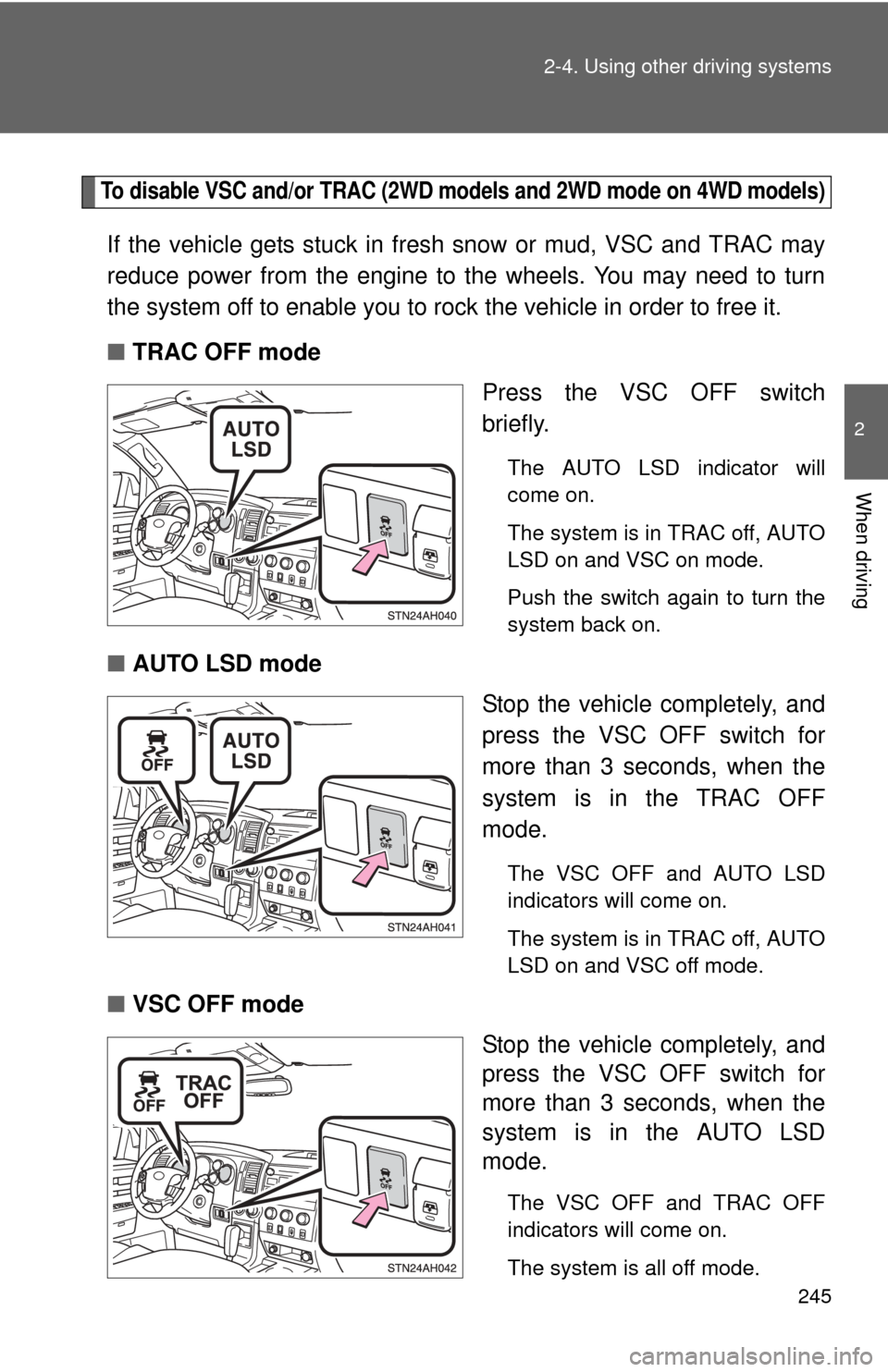
245
2-4. Using other
driving systems
2
When driving
To disable VSC and/or TRAC (2WD models and 2WD mode on 4WD models)
If the vehicle gets stuck in fresh snow or mud, VSC and TRAC may
reduce power from the engine to the wheels. You may need to turn
the system off to enable you to rock the vehicle in order to free it.
■ TRAC OFF mode
Press the VSC OFF switch
briefly.
The AUTO LSD indicator will
come on.
The system is in TRAC off, AUTO
LSD on and VSC on mode.
Push the switch again to turn the
system back on.
■AUTO LSD mode
Stop the vehicle completely, and
press the VSC OFF switch for
more than 3 seconds, when the
system is in the TRAC OFF
mode.
The VSC OFF and AUTO LSD
indicators will come on.
The system is in TRAC off, AUTO
LSD on and VSC off mode.
■VSC OFF mode
Stop the vehicle completely, and
press the VSC OFF switch for
more than 3 seconds, when the
system is in the AUTO LSD
mode.
The VSC OFF and TRAC OFF
indicators will come on.
The system is all off mode.